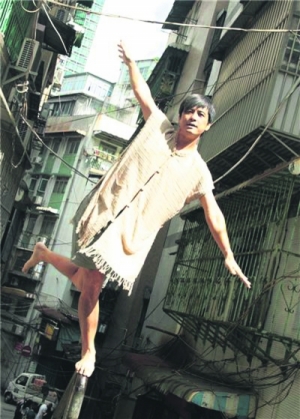A video showing lines and circles in different changing patterns and orientations with strong rhythmic beat stopped suddenly when a shadow lying on the stage appeared. She glowed while her surrounding was dark. She moved her hand, then arm, and then the whole body, just like a newly-born in a chaotic world. A group of dark people appeared and began to catch and surround her. She escaped but they surrounded her again. Finally, she became dark too, just like them.
The theme of escaping the influence from others was reiterated and intensified by the second and third scenes – a woman tried to escape by climbing over the body of a man who tried to fix her to a screen by covering her with his body; another woman tried to control her disobedient shadow to match her actions, finally both of them becoming mirror images of each other. The interaction between dancers and between dancers and EyeCon/Kalypso on stage is a parody of the dialectical relationship between self and others. In realizing our individuality in the world, how much effort should we pay to actually escape the shadow (influence) of others, especially those who socialize us? Are we doomed to fail in this (im)possible mission because we are a part of the world that shapes us in return?
Living in the world means leaving marks on ourselves and our surroundings. A woman and a man stood in front of the screen. When they moved, they would turn dark, just like they were being corrupted by their own movements. Two dancers laid at the top of the slanting stage. Once they moved, pieces would drop from them – the bigger the movement, the more pieces dropping. These traces and marks create our subjectivity of existence in the world. Yet they are not enduring, nor are we, nor was the performance. What we leave is only representation – memory, photos, videos, epitaphs…Yet these representations can be powerful in changing the lives of the living ones, just like the interpretation of dance/theatre would never be the same again after the Mortal Engine.
Post-modernism sheds light on the fact that many distinctions are human creations. “Is it a dance show?” or “Should a dance show be like this without much human performance?” may be questions for Mortal Engine. In fact, does it really matter? Our civilization has its own background and thus easily leads to citation and reiteration when we make reference to the existing structure in understanding our own creations. It is inevitable. Yet new invention can indeed reverse or change our convention. When machine or engine becomes the main character of the show, does it really mean that it loses the essence of a dance show? Should human be the major performers in a dance show? Can human creativity also be manifested through technology rather than the body? If “hell is other people” (l'enfer, c'est les autres) as Sartre has suggested in No Exit, is this stubborn structure also a hell to our creativity?
The distinct categories of art come out of the structure that grows out of the accumulated experiences of our ancestors, forming a structure. This structure can be as restrictive as the green “walls” that confined the dancers or as heavy as the people crowded on the female dancer. Yet it can also be illusory as long as we realize that it is not as natural as we thought – the touching fingers between God and Adam should be able to remind us that the world has already been created by human before we are here. In the simplest form, it is communication of ideas that is central to all kinds of performance.
Indeed, the most difficult thing to escape is our mindset.
「藝評新世代──藝評寫作導領計劃2010」由康樂及文化事務署(新視野藝術節)主辦,國際演藝評論家協會(香港分會)策劃及統籌。
本網站內一切內容之版權均屬國際演藝評論家協會(香港分會)及原作者所有,未經本會及/或原作者書面同意,不得轉載。










